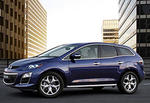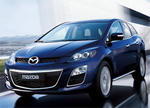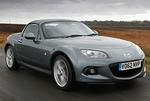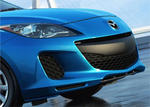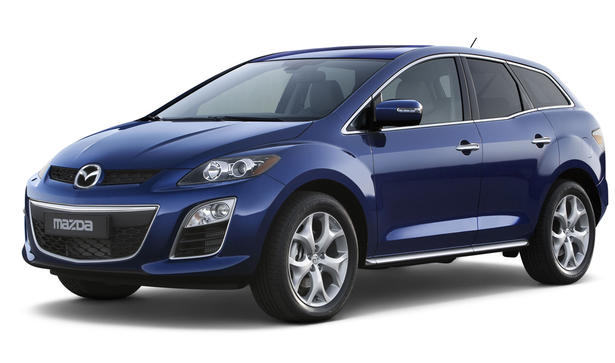
The second premiere from the Japanese manufacturer at this year's Geneva show is the 2009 Mazda CX7 facelift. The 2009 Mazda CX7 facelift features a larger Mazda five-point lower grille with silver-look detailing, new front fog light bezels and a new chrome-plated garnish along the bottom of the doors. The rear of the 2009 Mazda CX7 facelift features a new bumper design and a larger roof spoiler. The interior of the 2009 Mazda CX7 facelift has been updated with new materials.
In terms of engine options the 2009 Mazda CX7 facelift offers a new MZR-CD 2.2-litre common-rail turbo diesel unit which is Euro V compliant. Powered by this engine, the 2009 Mazda CX7 facelift develops 127 kW/173 PS at 3,500 rpm and 400 Nm of torque at 2,000 rpm.
Mazda Press Release:
Mazda CX-7 Facelift Clean Turbo Diesel for Europe
Updates At a Glance
Exterior
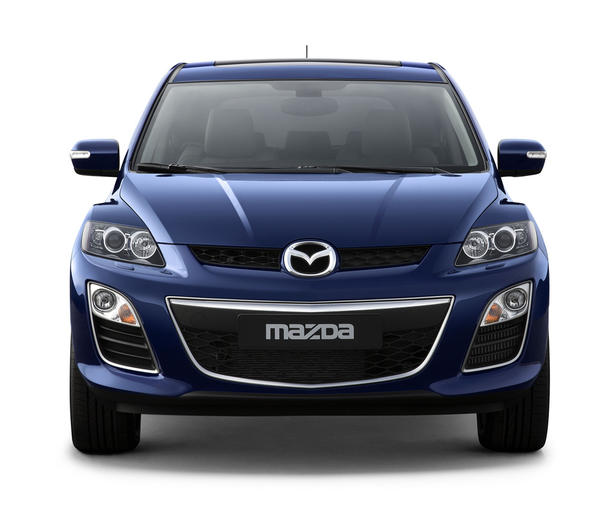
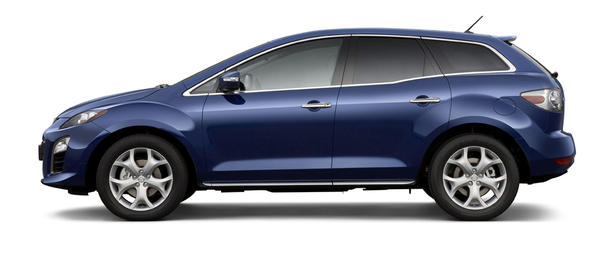
- Refined exterior design that communicates a clearer premium identity
- New larger Mazda five-point lower grille for a stronger Mazda identity and, for diesel models, improved cooling performance
- Lower grille framed in stylish, silver-look detailing for a more premium look (depending on grade)
- New front fog light bezels for a look of quality craftsmanship
- New chrome-plated garnish along the bottom of the doors that emphasis the vehicle’s sporty silhouette (depending on grade)
- Enhanced rear bumper design with rear moulding and a larger roof spoiler
- 7 body colors including 3 all-new colors: Aluminum Metallic, Stormy Blue Mica and Sparkling Black Mica
- New 19-inch aluminum-alloy wheels (depending on grade)
- Newly-designed 18-inch wheels for enhanced refinement (depending on grade)
Interior
- Interior materials updated for enhanced quality feel
- New center console lid/armrest with high-resilience urethane lid for comfort and durability
- Steering wheel redesigned with a more premium look and feel
- Blackout meters with blue-ring illumination, white pointers and three-dimensional dials
- Revised Double-roof dashboard with integrated MID
- Piano black or metallic look edging (depending on grade) on the center panel for a look of refinement
- Anti-glare chrome detailing on the air vents
- Front and rear door armrests with soft padding for quality and comfort
Equipment
- Multi Information Display (MID) above the center panel for driver information, rear view camera and navigation (depending on grade and market) for improved driver functionality
- Optional compact navigation system with 4.1-inch high-resolution liquid crystal display (LCD) located in the MID that is easier to use
- Bluetooth-compatible audio player system that plays music from portable music players through a wireless connection (depending on grade), using controls on the audio panel or the steering wheel
- Power-adjustable driver seat with seat memory settings
- Power-adjustable recline for passenger seat for finding just the right position
Powertrains
- New MZR-CD 2.2-litre common-rail turbo diesel with Euro Stage V compliance, that is clean running, highly fuel efficient, powerful and fun to drive:
- Produces maximum output of 127 kW/173 PS at 3,500 rpm and maximum torque of 400 Nm at a low 2,000 rpm, while using just 7.5 liters of fuel per 100 km (combined)
- Euro Stage V compliance
- Common-rail direct injection with 200 MPa injection pressure for high power and torque with low emissions
- Newly optimized intercooler efficiency for strong, linear power development
- Employs a new Selective Catalytic Reduction (SCR) system with a special urea additive to reduce NOx emissions
- A front chain drive cassette-type balancer shaft helps reduce NVH
- DOHC valve system is chain-driven for maintenance-free operation
- Electro-hydraulic power assisted steering (EHPAS) standard for diesel models that contributes to predictable handling in all situations and lower fuel consumption
- High-performance MZR 2.3-litre DISI Turbo petrol:
- Produces maximum output of 191kW/260 PS at 5,500 rpm and 380 Nm of maximum torque at 3,000 rpm for sports car performance
-Mazda exclusive under-floor catalyst employing single-nanotechnology which reduces the amount of precious metals needed
Chassis + Safety
- New body shell reinforcements achieve a five percent increase in torsional rigidity for a further improvement in handling and ride comfort
- Weld bonds introduced for some of the new body reinforcements to minimize the weight increase while enhancing strength
- MacPherson strut front and multi-link rear suspension systems (carry-over) for predictable handling in all situations
- New dampers realize smoother suspension strokes, for improved stability and ride comfort
- Active Torque-Split All-Wheel Drive (AWD) system (carry-over) for all models
- Rear Vehicle Monitoring system (RVM) that detects if a car is approaching from the right or left rear and warns the driver before he changes lanes (depending on grade)
- Emergency Stop Signal (ESS) that automatically flashes hazard lights if driver brakes abruptly at high speeds
Introduction –
Clean Turbo Diesel for Europe
The facelift version of Mazda’s popular sports crossover SUV, the CX-7, features the premiere of its first diesel variant. After a successful launch in North America in 2006, sales were expanded to include Japan and Europe in 2007. Two years later, total sales have surpassed 165,000 units (as of December 2008) and the CX-7 has won more than 10 global automobile awards.
In developing the facelift CX-7, Mazda focused on delivering a car that is even more representative of the Mazda brand. It has an enhanced balance of styling, dynamics and affordability for even more global appeal, and stays true to Mazda’s ‘Sustainable Zoom-Zoom’ plan, which aims to harmonize driving pleasure with environmental and safety features.
To address strong demand in Europe for a clean-running diesel with high fuel-efficiency, the Mazda CX-7 SUV facelift has a next-generation MZR-CD 2.2-litre turbo diesel including a selective catalytic reduction (SCR) system designed exclusively for the European market. It delivers a generous 400 Nm of torque to the road using Active Torque-Split All-Wheel Drive (AWD) system and joins the already well-known, high performance 2.3 litre DISI Turbo petrol engine in the line-up. And for the first time ever, Mazda’s sports crossover SUV gets a Rear Vehicle Monitoring (RVM) system and an Emergency Stop Signal (ESS) for even more active safety.
“I believe the new CX-7 is ideally positioned to compete around the world as a sustainable crossover SUV that’s a joy to own and to drive,” says Programme Manager Masashi Otsuka. “It moves away from the North American development and marketing focus of the current CX-7 and creates a true global model. Consequently, it was vital to adopt better powertrain technologies – for example a diesel engine – and raise interior and exterior quality in ways that reflect the tastes of customers around the world, thereby giving the facelifted CX-7 a competitive position in diverse markets.”
Design – Refined for a Clearer Premium Identity
The exterior design of the facelift is based on the athletic styling of the original CX-7, pushing further the sports crossover SUV design, while incorporating enhancements that more clearly communicate a premium identity and give it a more refined character. The CX-7 facelift’s new front end, detailing and high build quality on the outside take the original model’s advanced and emotional styling to the next level, while new materials and forms on the inside give the cabin a more premium look and feel.
Exterior Design
Front end – more refined for a more premium look
The new lower front grille of the CX-7 facelift has a larger five-point design that more clearly communicates the Mazda brand, and harmonizes it with the latest models in the line-up. The grille is framed by a stylish silver look, detailing that expresses a premium identity. It also provides a larger opening area that contributes to superior cooling performance, which is of particular value to the newly-introduce 2.2-litre turbo diesel engine. Other enhancements to the fascia include a new design for the front fog lamp bezels, which creates a strong visual flow and lends a sense of fine craftsmanship.
Silhouette and rear end
On the sides, newly adopted chrome-plated garnish (depending on grade) along the bottom of the doors highlights the vehicle’s sporty silhouette. At the rear, the CX-7 facelift has a new chrome bar on the tailgate handle, while a new and larger rear roof spoiler (depending on grade) complements the design revisions at rear end.
Colors and wheels
A line-up of seven body colors is available with the Mazda CX-7 facelift (depending on market), all of them chosen to compliment the vehicle’s sporty and strong exterior. These include three new colors: Aluminum Metallic, Stormy Blue Mica and Sparkling Black Mica. Mazda has carried forward the two original model’s popular black and sand beige interior colour packages. The facelifted CX-7 features newly designed 18-inch aluminum wheels and, for the first time to the line-up, new 19-inch aluminum wheels (both depending on grade), which further highlight the new CX-7’s power and refinement.
Interior Design – Quality Detailing
Cockpit – new steering wheel
The enhanced premium look on the outside is continued on the inside of the vehicle with quality detailing that delivers a sporty yet highly refined cabin. The CX-7 cockpit has a new steering wheel with a sporty, premium design. Integrated steering wheel switches allow the driver to operate controls without having to look away from the road. A new design for the blackout meters of the metre cluster features newly-introduced blue-ring illumination, white pointers and three-dimensional dials that produce a heightened sense of quality.
Dashboard and center panel updates
The vehicle’s unique double-roof instrument panel is modified as well. The upper roof is no longer straight but has a gently undulating shape. This was adopted so designers could install the new Multi Information Display (MID) positioned in the center and to the right of the driver for easy reading. Piano black or metallic edges are added to the center panel to convey a sense of refinement.
Materials and trim
The CX-7 facelift interior was developed with new materials placed at various locations around the cabin to give an even more premium look and feel. The rings on the side air conditioner vents are specially plated with anti-glare chrome. New front and rear door armrests are introduced as well, which incorporate soft pads for enhanced quality feel and more comfort than before. The armrest lid of the center console is made of thick, high-resilience urethane, which has a texture combining softness and firmness for durability and comfort. With high grades, it also has a newly added soft pad.
Equipment – Advanced Functionality
Advanced equipment is introduced to the CX-7 facelift that provides even more functionality to the driver and passengers, and makes Mazda’s sports crossover SUV easy and fun to use on a daily basis. Like Mazda’s new-generation Mazda6 and Mazda3, the updated CX-7 has a new human-machine interface (HMI) that encompasses advanced driver functionality and contributes to greater driving confidence, mainly due to its Multi Information Display.
New Multi Information Display (MID) – optimised driver information
To provide the driver with necessary information in an optimal way, a new Multi Information Display (MID) is introduced with enhanced capabilities, and positioned at the top of the center console under the shadow of the top roof of the dashboard to be easily read. It shows current driving information like fuel consumption, maintenance indicators, rear view camera and navigation – a separate display showing audio and climate-control information, and a warning lamp area below this with a seatbelt warning and airbag cut-off indicator. There are two types of liquid crystal displays (LCD) available for the MID: a high-brightness, high-resolution 4.1-inch colour type, and a 3.5-inch monochrome dot matrix type. These are the same types as available for the all-new Mazda3.
Rear view camera and new compact navigation system with high resolution display
Some versions of the CX-7 are equipped with a rear camera that makes backing up easier. The camera’s pictures are shown on the 4.1 inch colour TFT display being standard on those vehicles a compact navigation system (depending on grade) is also newly introduced to the CX-7 facelift that displays a map on the colour TFT display located in the MID as described above. It is operated by switches on the steering wheel and, combined with the high legibility of the display, makes operation and visual confirmation of readouts safe and easy while driving. The development team also focused on upgrading the basic functions and adopted a map database system stored on a compact SD card for more practicality.
New Bluetooth-compatible audio player system
Mazda’s facelifted sports crossover SUV also has Bluetooth wireless connection technology for mobile phones for the first time (depending on grade), which may be operated hands-free while driving. The system is more than that, however. It also provides a wireless connection between Bluetooth -compatible portable audio players and the CX-7 audio system. Music playback from the audio player can be controlled by switches located on the audio panel or the steering wheel while driving. Additionally there’s an AUX jack located at the front of the center console so that music on non-Bluetooth -compatible portable audio players may also be enjoyed using the vehicle’s factory-fitted audio system.
New driver seat memory function and power-adjustable passenger seat
The driver seat of the CX-7 facelift is designed to provide the optimum driving position for all types of people, and is now power-adjustable with a three-position memory function (depending on grade). The passenger seat on high grade models is power adjustable now.
Powertrains – New Clean-Running 2.2-litre Turbo Diesel
In response to growing environmental concerns and increasingly stringent emission regulations in Europe, the CX-7 facelift engine line-up delivers a newly evolved combination of sporty, refined driving performance, with superb fuel efficiency and environmental performance. For the first time, a new, powerful and low-emission 2.2-litre common-rail diesel engine, developed especially for Europe joins the 2.3-litre DISI turbo petrol.
New MZR-CD 2.2 diesel – high torque with 7.5 litre/100 km (combined) fuel consumption
The next-generation MZR-CD 2.2-litre inline four-cylinder DOHC 16-valve turbo diesel joins the line-up of the facelifted CX-7. It delivers generous maximum torque of 400 Nm at a low 2,000 rpm and maximum output of 127 kW/173 PS at 3,500 rpm.
The engine’s 2.2-litre displacement, combined with turbocharger and common-rail direct injection with a high injection pressure of 200 MPa, realizes high power and torque with low emissions. Newly optimized intercooler efficiency further promotes strong and linear performance.
Cost-saving 2.2 litre DOHC turbocharged common-rail diesel
To keep customers costs low when driving, the DOHC-valve system is chain driven which allows a maintenance-free operation.
Balancer shaft and lower block for less engine noise
A front-chain-drive cassette-type balancer significantly reduces NVH. Employing this balancer improves booming noise, and produces a linear relationship between the accelerator pedal position and the engine sound, contributing to the fun-to-drive feeling.
Advanced diesel particulate filter from Mazda
Together with the 2.2 litre DOHC turbocharged common-rail diesel, a newly-developed diesel particulate filter made of a ceramic material with high thermal resistance - including Mazda’s independently developed catalyst - is introduced. In addition to oxygen in the exhaust gases, this catalyst uses oxygen stored in the base material, to improve the combustion of soot emissions. This optimises the time needed for the generation of the filter (shortened by 1/3) and realises excellent emissions, without sacrificing performance for driving fun.
With the new turbo diesel under the bonnet, the Mazda CX-7 facelift sprints from 0-100 km/h in 11.3 seconds with a top speed of 200 km/h. And new to the CX-7 line-up with the MZR-CD 2.2-litre diesel is a selective catalyst reduction (SCR) system, the first ever on a Mazda vehicle that converts NOx into harmless nitrogen and water using a urea additive.
High performance MZR 2.3 DISI Turbo petrol engine
The Mazda CX-7 facelift engine line-up retains the acclaimed inline four-cylinder DOHC 16-valve 2.3-litre DISI Turbo petrol. It produces high maximum output of 191kW/260 PS at 5,500 rpm and 380 Nm of maximum torque at 3,000 rpm.
Advanced catalyst technology
As in the Mazda3, CX-7 facelift models with the MZR 2.3L DISI Turbo engine feature Mazda's exclusive underfloor single-nanocatalyst. It employs single-nanotechnology, which can control even smaller particles than nanotechnology. Due to this advanced technology, the amount of precious metal used in the catalyst has been reduced by approximately 73 percent compared to the current model. The total weight of precious metal per unit has been cut from 0.89 grams to 0.24 grams. This new Mazda technology helps limit the use of rare natural resources and contributes to preserving the environment.
Chassis – Enhanced Handling and Ride Quality
Mazda pioneered the sports crossover SUV sub-segment when it launched the original CX-7 as a practical but sporty utility vehicle. The facelift model enhances this aspect with a significant increase in body rigidity and suspension updates. Coupled to Active Torque-Split All-Wheel Drive (AWD) system, this delivers even better handling stability and ride comfort for an even more premium driving experience befitting Mazda’s flagship SUV.
Body shell – a 5 percent increase in torsional rigidity
Mazda engineers added body reinforcements to the CX-7 facelift for a five percent increase in torsional stiffness, which translates into even better handling stability and a higher-quality ride. To minimize the weight increase that resulted from the addition of some of these reinforcements, Mazda used weld bonds, which are relatively light joints where spot welds are supplemented by adhesive between the welded parts. And the increased body rigidity further enhances quietness by softening the tone of road noise before it reaches the cabin.
Suspension – excellent straight-ahead stability and ride comfort
Tuned to suit the power characteristics of each engine, the suspension system of the Mazda CX-7 facelift employs MacPherson struts in the front and a multi-link suspension system in the rear. New dampers are introduced with larger oil-flow openings to achieve smoother suspension strokes and improve stability and ride comfort. At the same time, the increased body rigidity helps enable supple suspension movement and greater firmness.
Mazda’s Active Torque-Split All-Wheel Drive (AWD) system – superior traction
Like the original model, the European version of the Mazda CX-7 facelift comes standard with Mazda’s Active Torque-Split All-Wheel Drive (AWD) system that helps prevent wheel spin on slippery surfaces and delivers excellent traction on dry surfaces. The vehicle’s system control module distributes torque between the front and rear axles using an electronically-controlled active-torque coupling mounted in front of the rear differential. The system automatically distributes power between the axles (100/0 percent to 50/50 percent front/rear) for just the right amount of torque in every driving situation.
Steering system – Electro-hydraulic power assisted steering standard for 2.2-litre diesel
Electro-hydraulic power assisted steering (EHPAS) in vehicles with the MZR-CD 2.2 engine ensures a precise, positive steering feel by employing hydraulic pressure provided by a pump that is driven by an electric motor. Precise control over the degree of steering assistance in accordance with the speed of the vehicle, and the speed at which the steering wheel is turned, helps to minimize unnecessary fuel consumption, making the 2.2-litre turbo diesel even more frugal. Vehicles with the MZR 2.3 DISI Turbo engine are equipped with hydraulic power assisted steering that is also tuned to deliver optimal steering assist depending on vehicle speed.
Safety – New Rear Vehicle Monitoring and Emergency Stop Signal
The CX-7 facelift is not only in line with Mazda’s Sustainable Zoom-Zoom Strategy for environmental performance, but for safety as well. Two newly introduced elements enhance the active safety package of Mazda’s sports crossover SUV.
Rear Vehicle Monitoring (RVM) system
The Mazda CX-7 receives Mazda’s Rear Vehicle Monitoring (RVM) system for the first time. It has radar sensors in the rear bumper that detect a vehicle approaching from behind when the vehicle is moving at a speed of 60 km/h or faster. The 24 GHz radar sensors have a range of 50 m behind the vehicle and are not affected by bad weather. If a car is detected approaching from the left or right rear lanes or driving in the blind spot next to the vehicle, the system alerts the driver by turning on a warning indicator in the door mirror on the relevant side. If the driver then activates a turn signal, the indicator in the door mirror flashes and a warning buzzer sounds to prevent the driver from changing lanes.
Emergency Stop Signal (ESS)
A new ESS system is introduced with the CX-7 facelift. When the CX-7 is travelling faster than 50 km/h and the driver brakes sharply, the ESS system automatically flashes the hazard warning lights rapidly to alert following vehicles of the emergency situation.





